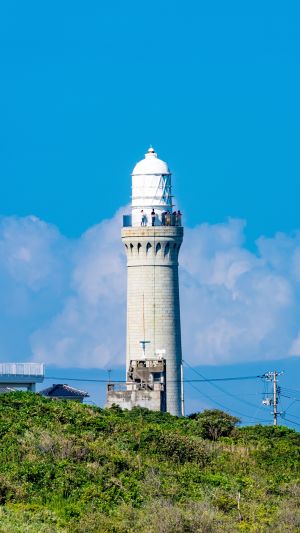Located on the picturesque Tsunoshima Island in Yamaguchi Prefecture, Japan, the Tsunoshima Lighthouse is a symbol of maritime history and a marvel of scenic beauty.
Surrounded by the azure waters of the Sea of Japan, this iconic lighthouse stands as a gateway to breathtaking coastal landscapes, offering visitors a mix of tranquility and awe.
<h3>How to Get to Tsunoshima Lighthouse</h3>
<b>By Car</b>
The lighthouse is accessible by car via the Tsunoshima Bridge. It’s about a 2-hour drive from Yamaguchi City or a 1-hour drive from Shimonoseki City. Parking near the lighthouse is free.
<b>By Public Transport</b>
Take a train to Kottoi Station on the JR San’in Main Line, then catch a local bus to Tsunoshima. From the bus stop, it’s a short walk to the lighthouse.
<h3>Why Tsunoshima Lighthouse is a Must-Visit</h3>
<b>A Historical Landmark</b>
Built in 1876 by Scottish engineer Richard Henry Brunton, the Tsunoshima Lighthouse is one of Japan’s oldest Western-style lighthouses. It was constructed with high-quality granite and has been guiding ships safely for over a century.
<b>Stunning Panoramic Views</b>
The lighthouse offers stunning views of the vast ocean, rugged coastline, and the famous Tsunoshima Bridge, a scenic marvel in itself. The turquoise waters below and the dramatic skies above make it a haven for photographers and nature lovers.
<b>Secluded and Serene</b>
Unlike crowded tourist spots, Tsunoshima Lighthouse offers a peaceful retreat where you can connect with nature and take in the beauty of Japan's coastline.
<h3>What to Do at Tsunoshima Lighthouse</h3>
<b>Climb to the Top</b>
Visitors can climb the spiral staircase inside the lighthouse for a small fee (around $2–$3 USD). The view from the top is nothing short of mesmerizing, with the endless expanse of the ocean meeting the horizon.
<b>Explore the Lighthouse Grounds</b>
The area around the lighthouse features well-maintained paths, lush greenery, and seating spots, perfect for a leisurely stroll or a picnic.
<b>Visit Tsunoshima Bridge</b>
Don’t miss the chance to cross the Tsunoshima Bridge, which connects the island to the mainland. The 1,780-meter-long bridge offers postcard-perfect views of the sea.
<h3>Best Time to Visit</h3>
<b>Spring (March–May):</b> The island comes alive with blooming flowers and pleasant weather.
<b>Autumn (September–November):</b> Enjoy clear skies and cool breezes, making it ideal for sightseeing.
<h3>Accommodation Options Near Tsunoshima</h3>
<b>Cozy Inns</b>
Stay in traditional Japanese inns (ryokans) on the island or nearby towns. Prices range from $50–$120 USD per night, depending on amenities.
<b>Beachside Hotels</b>
Modern hotels along the coast offer stunning sea views and comfortable amenities, with rates starting at $70–$150 USD per night.
<h3>Dining Options</h3>
<b>Seafood Delights</b>
Enjoy freshly caught seafood dishes like grilled fish, sashimi, and octopus tempura at local restaurants. A meal typically costs $10–$20 USD.
<b>Casual Cafés</b>
Cozy up at seaside cafés offering coffee, pastries, and light snacks, perfect for a quick bite while enjoying the view.
The Tsunoshima Lighthouse isn’t just a beacon for ships—it’s a symbol of tranquility, history, and natural beauty. From the breathtaking views of the sea and the iconic Tsunoshima Bridge to the peaceful ambiance surrounding it, the lighthouse offers a memorable escape from the hustle of daily life. So, Lykkers, pack your bags and let this coastal wonder take your breath away!





